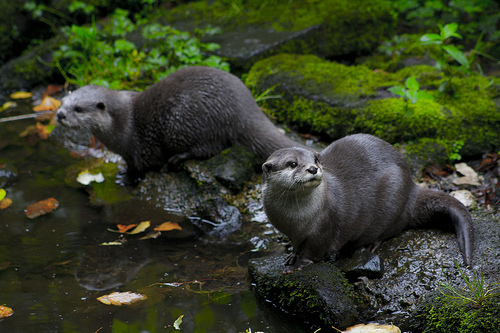Otters are exuberant animals with boundless energy and they dedicate all their spare time to play. In their case, play is not only a practice activity aimed at teaching the young the hunting and fighting skills they will need when older; it is also an end in itself.
The Playful Hunter
Otters, adapted to fish in the water, are always found near water – courses that offer a steady supply of food. They usually dig large under-ground burrows consisting of a main chamber, a ventilation shaft leading to the surface and an exit tunnel that opens into the water at a depth of a about one meter. Only rarely will they use the abandoned burrows of wild rabbits or other small animals, the young are born in the burrows: initially they are helpless and blind and remain under-ground for some four months until they are weaned.
Learning to Swim
Although the young instinctively know how to swim, they are very reluctant to actually plunge into the water, and it appears that their psychological adaptation to the aquatic life is not as highly developed as their physical adaptations.By fair means or foul, therefore, their mothers have to persuade them, to enter the water, often enticing them with mouthfuls of fish. The more timid will attempt to climb on their mothers’ backs, but as soon as they gain confidence in the water they reveal their exceptional swimming skills.
An otter swims by holding its front legs flat against its body and propelling itself along by moving its tail and hind legs. These animals love to twist and turn in the water, swimming for a while on their backs and then on their sides without any apparent motive. It is impossible to avoid the conclusion that they behave in this way for sheer pleasure.
Otters are exuberant animals with boundless energy and they dedicate all their spare time to play. In their case, play is not only a practice activity aimed at teaching the young the hunting and fighting skills they will need when older; it is also an end in itself. Even mature animals play amongst themselves.
They show every sign of thorough enjoyment, uttering a muted chuckling sound that also serves for communication with other otters. They are capable of a wide range of sounds, that include a high- pitched, modulated whistle, used as a mating call by adults and as an alarm call by the young to their mother when they feel themselves in danger. The alarm call of the adult is an irate squawking that can turn into a dog-like bark when the animal passes from a state irritation to one of outright menace. When not frightened, the young produce an insistent mewing sound.
Fisherman’s Friend
Otters are very easy to tame, and in China and India they are used by fishermen to drive fish towards their nets. Indeed, when there are plenty of fish, wild otters will drive them towards a narrow creek where they can be caught more easily; several females often join forces to carry out this operation.
Small fish are devoured immediately, but larger fish are brought to the bank – sometimes one is held in the mouth while another is held against the body with the forefeet. The prey can then be divided up at leisure and the young given their share.
Endangered Species
The only natural enemy of the common otter is man. In Europe this species is at risk of extinction, so drastically have the numbers been reduced by hunting and disturbance. Otters are also seriously threatened by the despoilment of river habitats and pollution.






